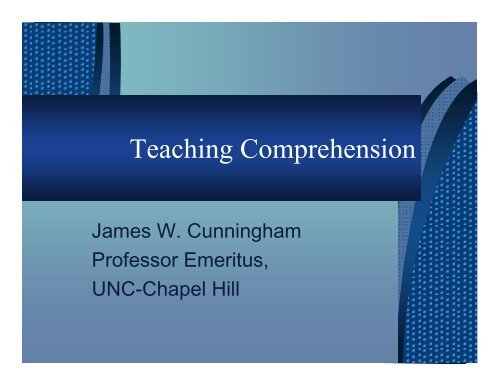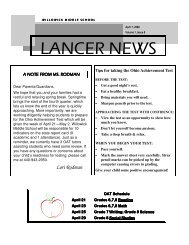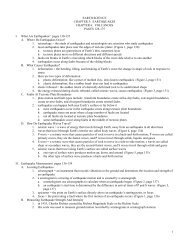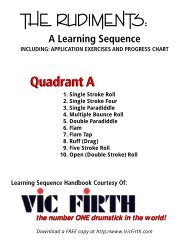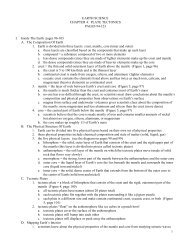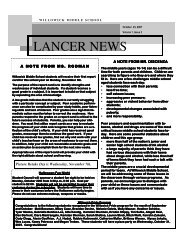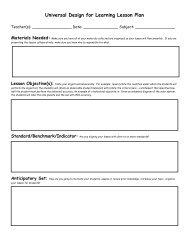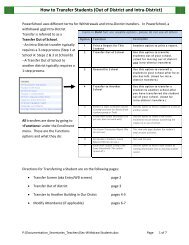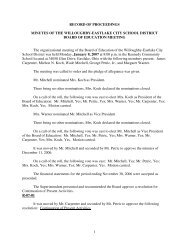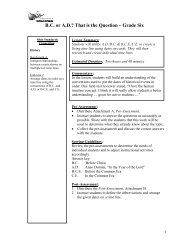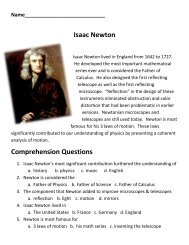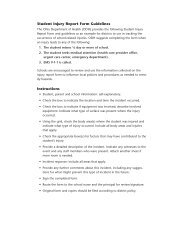Teaching Comprehension
Teaching Comprehension
Teaching Comprehension
Create successful ePaper yourself
Turn your PDF publications into a flip-book with our unique Google optimized e-Paper software.
<strong>Teaching</strong> <strong>Comprehension</strong><br />
James W. Cunningham<br />
Professor Emeritus,<br />
UNC-Chapel Hill
America’s Reading Problem is a<br />
<strong>Comprehension</strong> Problem
Carnegie Report<br />
Biancarosa, C., & Snow, C. E. (2006).<br />
Reading next—A vision for action and<br />
research in middle and high school<br />
literacy: A report to Carnegie<br />
Corporation of New York (2nd ed.).<br />
Washington, DC: Alliance for Excellent<br />
Education.
Carnegie Report<br />
“American youth need strong literacy skills to<br />
succeed in school and in life. Students who do not<br />
acquire these skills find themselves at a serious<br />
disadvantage in social settings, as civil participants,<br />
and in the working world. Yet approximately eight<br />
million young people between fourth and twelfth<br />
grade struggle to read at grade level. Some 70<br />
percent of older readers [in grades 4-12] require<br />
some form of remediation. Very few of these older<br />
struggling readers need help to read the words on a<br />
page; their most common problem is that they are not<br />
able to comprehend what they read.” (p. 11)
2005 National Assessment of<br />
Educational Progress (NAEP) in<br />
Reading<br />
36% of 4 th graders were below Basic*<br />
69% of 4 th graders were below Proficient<br />
*Not significantly different from 1992
Why is there such a serious problem<br />
with reading comprehension<br />
Poverty<br />
Lack of reading comprehension<br />
instruction
Lack of <strong>Comprehension</strong> Instruction<br />
Durkin, D. (1978-1979). What classroom<br />
observations reveal about reading<br />
comprehension instruction. Reading<br />
Research Quarterly, 14, 481-533.
Lack of <strong>Comprehension</strong> Instruction<br />
Pressley, M., Wharton-McDonald, R.,<br />
Mistretta-Hampston, J., & Echevarria,<br />
M. (1998). Literacy instruction in 10<br />
fourth- and fifth-grade classrooms in<br />
upstate New York. Scientific Studies of<br />
Reading, 2, 159-194.
Lack of <strong>Comprehension</strong> Instruction<br />
“Practice of comprehension strategies but<br />
virtually no instruction in strategy use” (p. 170).<br />
“we were struck by the almost complete<br />
absence of direct instruction about<br />
comprehension strategies.” (p. 172)<br />
“we observed only rare instances of explicit<br />
comprehension instruction. Indeed, the situation<br />
still seems to be much as Durkin described,<br />
with a great deal of testing of comprehension<br />
but very little teaching of it.” (p. 187)
Lack of <strong>Comprehension</strong> Instruction<br />
RAND Reading Study Group. (2002).<br />
Reading for understanding: Toward an<br />
R&D program in reading<br />
comprehension. Santa Monica, CA:<br />
RAND.
Why isn’t there more reading<br />
comprehension instruction<br />
Too many teachers and administrators<br />
believe that having students practice<br />
comprehension is teaching<br />
comprehension
Practicing comprehension<br />
Taylor, B. M., Pearson, P. D., Peterson,<br />
D. S., & Rodriguez, M. C. (2003).<br />
Reading growth in high-poverty<br />
classrooms: The influence of teacher<br />
practices that encourage cognitive<br />
engagement in literacy learning. The<br />
Elementary School Journal, 104, 3-28.
Practicing comprehension<br />
“The more that routine, practiceoriented<br />
approaches to teaching<br />
important comprehension processes<br />
were observed, the lower the growth in<br />
reading comprehension.” (p. 23)
Why isn’t there more reading<br />
comprehension instruction<br />
Too many teachers and administrators<br />
believe that having students practice<br />
comprehension is teaching<br />
comprehension<br />
Too many teachers and administrators<br />
believe that assessing comprehension<br />
is teaching comprehension
Assessing comprehension<br />
Kober, N. (2001, April). It takes more than<br />
testing: Closing the achievement gap. A<br />
report of the Center on Education Policy.<br />
Washington, DC: Center on Education<br />
Policy.
Why isn’t there more reading<br />
comprehension instruction<br />
Too many teachers and administrators<br />
believe that having students practice<br />
comprehension is teaching<br />
comprehension<br />
Too many teachers and administrators<br />
believe that assessing comprehension<br />
is teaching comprehension<br />
Schools frequently wait to teach<br />
comprehension until it is too late
Why K-2 teachers delay teaching<br />
comprehension<br />
Overemphasis on phonemic awareness,<br />
phonics, oral reading accuracy, and oral<br />
reading fluency<br />
Overuse of decodable text<br />
Overuse of leveled books<br />
Overuse of retelling to assess comprehension<br />
Overuse of literal comprehension questions<br />
to assess comprehension
In classrooms that use leveled groups<br />
Chorzempa, B. F., & Graham, S. (2006).<br />
Primary-grade teachers’ use of withinclass<br />
ability grouping in reading. Journal<br />
of Educational Psychology, 98, 529-<br />
541.
In classrooms that use leveled groups<br />
“A random sample of primary-grade teachers<br />
from across the United States was surveyed”<br />
“Sixty-three percent of participants reported<br />
using within-class ability groups.”<br />
“students in lower ability groups spend more<br />
time involved in noninstructional activities, are<br />
less likely to be asked critical comprehension<br />
questions, and are given fewer opportunities<br />
to select their own reading material.” (p. 529)
Why isn’t there more reading<br />
comprehension instruction<br />
Too many teachers and administrators<br />
believe that having students practice<br />
comprehension is teaching<br />
comprehension<br />
Too many teachers and administrators<br />
believe that assessing comprehension<br />
is teaching comprehension<br />
Schools frequently wait to teach<br />
comprehension until it is too late
Summary, So Far<br />
America’s reading problem is a<br />
comprehension problem<br />
The problem is partially caused by poverty<br />
and partially by the lack of comprehension<br />
instruction<br />
There is a lack of comprehension instruction<br />
because comprehension practice and<br />
assessment are mistakenly assumed to teach<br />
it, and because schools put off teaching it<br />
until it’s too late
How to Teach Reading<br />
<strong>Comprehension</strong>
Before Reading<br />
During Reading<br />
After Reading<br />
The Three Phases of a Reading<br />
<strong>Comprehension</strong> Lesson
A During Reading Format<br />
How the teacher structures the “during<br />
reading” phase of the comprehension<br />
lesson
The Format<br />
Whole class, small group(s), or paired<br />
Teacher-, peer-, or self-guided<br />
Reading orally or to yourself<br />
Single copy or multiple copies<br />
Read whole selection or in segments<br />
First, second, or third reading
Some During Reading Formats<br />
Shared Reading<br />
Choral Reading<br />
Echo Reading<br />
ERT…<br />
Partner Reading<br />
Playschool Groups<br />
Three Ring Circus<br />
Coaching Groups<br />
Book Club Groups<br />
Pick a Page<br />
Bookmarks<br />
Etc.
How Formats Can Improve Reading<br />
<strong>Comprehension</strong> Instruction<br />
By providing extra support for students<br />
in reading the selection<br />
By multiplying the amount of reading<br />
students do in guided reading<br />
By making guided reading more<br />
multilevel (each format re-levels your<br />
students somewhat differently)
A Before and After Reading Activity<br />
What the teacher has students do<br />
before and after they read in order to<br />
help them learn to comprehend better
Some Before and After Reading<br />
Activities<br />
Think-Alouds<br />
Predicting<br />
KWL Charts<br />
Graphic Organizers<br />
Story Maps<br />
Beach Ball<br />
Group Discussions<br />
Sent/Para Detectives<br />
“Doing the Book”<br />
Drawing<br />
Beyond Retelling<br />
Etc.
The After Reading Task<br />
A variety of after reading tasks is<br />
necessary in order to teach a variety of<br />
comprehension strategies and text<br />
structures<br />
The most effective after reading tasks<br />
emphasize higher-order thinking
The After Reading Task<br />
Taylor, B. M., Pearson, P. D., Peterson,<br />
D. S., & Rodriguez, M. C. (2003).<br />
Reading growth in high-poverty<br />
classrooms: The influence of teacher<br />
practices that encourage cognitive<br />
engagement in literacy learning. The<br />
Elementary School Journal, 104, 3-28.
The After Reading Task<br />
“Participants included 88 teachers and 9<br />
randomly selected students per [grade 1-5]<br />
classroom in 9 high-poverty schools across<br />
the United States . . . . Looking across all the<br />
data, the most consistent finding was that<br />
teachers who emphasized higher-order<br />
thinking, either through the questions they<br />
asked or the tasks they assigned, promoted<br />
greater reading growth . . . .” (p. 3)
The After Reading Task<br />
A variety of after reading tasks is<br />
necessary in order to teach a variety of<br />
comprehension strategies and text<br />
structures<br />
The most effective after reading tasks<br />
emphasize higher-order thinking
The After Reading Task is a<br />
Group Task<br />
In a group task, the teacher completes<br />
the task in writing as the students in the<br />
class or group tell the teacher what to<br />
write<br />
In a group task, the teacher guides the<br />
process, but does not do the task for the<br />
group
The Before Reading Phase<br />
Unless students read with the after reading<br />
task in mind, they will not benefit from the<br />
lesson because they will not read any<br />
differently than they usually do<br />
Since the after reading task is done after the<br />
students have read, the before reading phase<br />
must preview or otherwise explain or show<br />
what the after reading task will be or the after<br />
reading task is only a test
<strong>Comprehension</strong> Lessons That Work<br />
Cunningham’s Law #67: It’s not any big<br />
thing, but a lot of little things that make<br />
comprehension lessons effective
<strong>Comprehension</strong> Lessons That Work<br />
Use a variety of during reading formats to<br />
provide extra support for students, to multiply<br />
the amount of reading they do each lesson,<br />
and to make guided reading more multilevel<br />
Use a variety of after reading tasks, many of<br />
which emphasize higher-order thinking, to<br />
teach a variety of comprehension strategies<br />
and text structures<br />
Use a group task after reading to increase<br />
motivation and success
<strong>Comprehension</strong> Lessons That Work<br />
Make sure the before and after reading<br />
phases are closely linked and aligned<br />
Make sure the before reading phase<br />
forecasts the specific after reading task<br />
the students will do
Planning a Reading <strong>Comprehension</strong><br />
Lesson<br />
A reading comprehension lesson has 3<br />
phases (before, during, after), but only 2<br />
parts (during reading format, before and<br />
after reading activity)
Some Before and After Reading<br />
Activities<br />
Think-Alouds<br />
Predicting<br />
KWL Charts<br />
Graphic Organizers<br />
Story Maps<br />
Beach Ball<br />
Group Discussions<br />
Sent/Para Detectives<br />
“Doing the Book”<br />
Drawing<br />
Beyond Retelling<br />
Etc.
Some During Reading Formats<br />
Shared Reading<br />
Choral Reading<br />
Echo Reading<br />
ERT…<br />
Partner Reading<br />
Playschool Groups<br />
Three Ring Circus<br />
Coaching Groups<br />
Book Club Groups<br />
Pick a Page<br />
Bookmarks<br />
Etc.
Integrating Writing with Reading<br />
<strong>Comprehension</strong><br />
Do not have students write in the after<br />
reading task<br />
Instead, occasionally plan a writing<br />
lesson that follows the reading<br />
comprehension lesson and is linked to it


